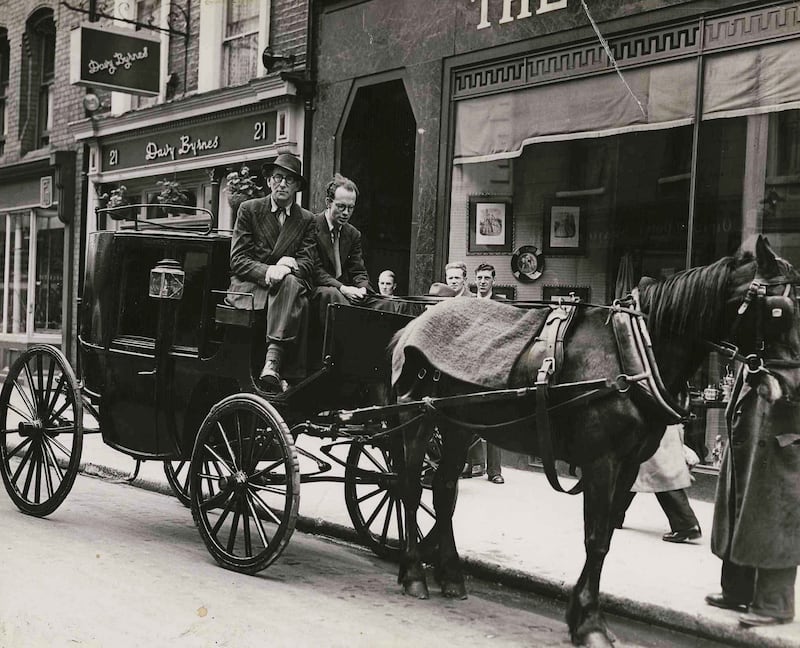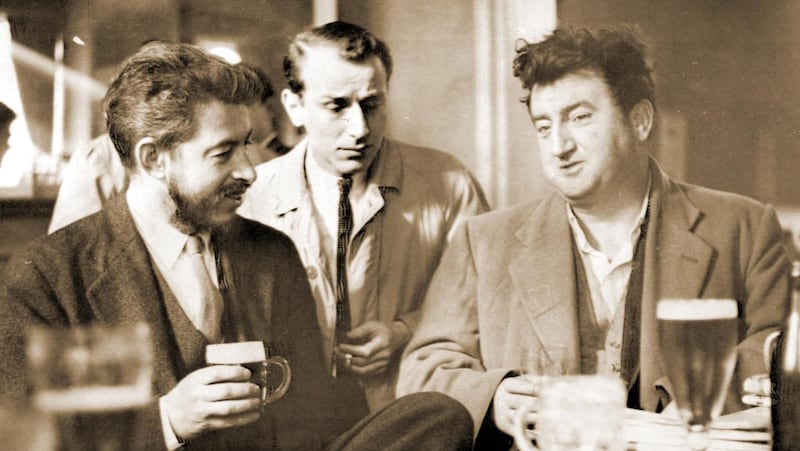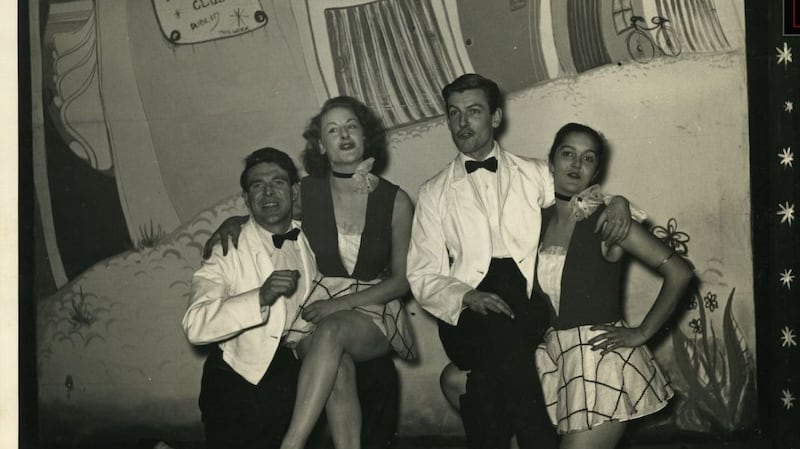More an idea than a place, Baggotonia is a part of Dublin that one can’t find on any map.
Geographically, its epicentre is Dublin’s Baggot Street Bridge, from where it extends more than a kilometre in every direction. For some three decades, beginning in the 1940s, this phantom address was a bohemian and intellectual centre, where such literary luminaries as Flann O’Brien, Brendan Behan and Patrick Kavanagh lived and roamed.
It’s also a place where veteran filmmaker Alan Gilsenan – whose family moved from Meath to Raglan Road during his childhood – spent many formative years. He was an altar boy at St Bartholomew’s Church nearby. In his youth, he explored many empty spaces and lanes that have since been developed into offices and hotels.
“It was a far more complex and interesting area,” he recalls. “There were embassies and a certain glamour. A lot of people with foresight about Ireland moved in. There were very few families. But there were the people that lived there forever. There were loads of bedsits since many people came up from the country for the week and went home. It was often deserted at weekends.”
The Surfer review: Nicolas Cage, after too many wipeouts, catches a great wave
Look inside: Graham Norton selling his homes in London and New York
Kevin Hart at 3Arena review: Our phones are sealed in pouches before the show starts. It has a surprising effect
‘I was overheard saying my date wasn’t very good-looking. Now he’s blocking me’
Decades on and the writer-director is returning to his old haunts for an account that is more meditation than reportage. Gilsenan’s sister, he concedes, has disputed some of the recollections gathered in his new film, Ghosts of Baggotonia. It’s complicated. He’s not even sure about his memories of Patrick Kavanagh.

“Kavanagh was really only appreciated later on,” says Gilsenan, whose film explores the imagined cultural space of the title. “I remember him as an eccentric, outsider character. He was a benign presence. You weren’t afraid of him. But he was seen as this kind of wayward tramp wandering around Baggot Street and Pembroke Road. In a way, that’s where the whole idea of ghosts came from. Because I have a recollection – but I’m not sure if it really happened – of meeting Kavanagh with my father on Pembroke Road. I was very young. And I remember the railings outside his house. It’s not important if it really happened. I love the idea of the past and present and our memories and our lived experiences coexisting.”
Ghosts of Baggotonia is an eerie, compelling work of psychogeography in the style of Patrick Keiller’s Robinson films or of much of Pat Collins’s oeuvre.
Uncanny connections
The narration – often provided by the film-maker – comprises personal reflections and writings from many former Baggotonia residents and associates, including Elizabeth Bowen, Samuel Beckett, Blanaid Salkeld, Eavan Boland, Paul Durcan, Ethna McCarthy and Thomas Kinsella.
Gilsenan’s connections with Baggotonia are as complex as any of the recited poems. At Trinity College Dublin – where he gained a first in modern English and sociology – he received the inaugural AJ Leventhal postgraduate scholarship. It’s the first of a series of almost uncanny connections between the author and his material.
“Leventhal was a great friend of Beckett’s,” says Gilsenan. “He was a theatre critic. He was a great man of the arts. So I kind of became interested in Leventhal and Beckett. One of the people who initiated this scholarship was Prof Eoin O’Brien. He was a very eminent cardiologist, but also an old-school man of letters and a close friend of Beckett. Over the years, I stayed in touch with Eoin O’Brien. And one of the things we discovered was that we went to the same school but in different eras.”

It was O’Brien who introduced Gilsenan to the term “Baggotonia”. Writing in the Dublin Review of Books last April, O’Brien suggested that: “My love for Baggotonia may be attributable to having spent my early childhood and much of my schoolboy days there. Later I walked, drank, loved and learned in Baggotonia while studying medicine in the Royal College of Surgeons on Stephen’s Green. The small enclave of Baggotonia extended from the banks of the Grand Canal and its bridges at Baggot Street, Leeson Street and Mount Street, along Baggot Street, dotted at that time with meagre flats and studios, past the park of Fitzwilliam with its little shelter, fountain and tennis courts, and onwards to Stephen’s Green, with its lake of ducks and swans, to the epicentre of Baggotonia on Grafton Street, and its little side-streets dotted with pubs, cinemas, cafes and shops.”
Some decades earlier, Olivia Robertson, a friend of WB Yeats, noted that, “Dublin has its own special colony of Bohemia, (a) Latin Quarter, which I shall call the Baggot Street Quarter.”
More connective tissue: Robertson, a mystic and high priestess of the Fellowship of Isis, once owned the Raglan Road property that Gilsenan lived in as a youngster.
It’s D4, but not as we know it.
Flourishing underground
“I had never heard of the term Baggotonia,” recalls Gilsenan. “But when I started to read about it – there’s a wonderful book by Brendan Lynch on it – it definitely emerged as a movement in as much as these things can be. There was an underground, flourishing from the 1940s and 1950s, even tumbling into the 1980s, which was cultural long before culture was fashionable. These people were radical and were working under the dark cloud of Archbishop McQuaid, working on magazines and in theatres and on many forgotten things. And it seemed to me, whatever one thinks about the title Baggotonia, that does capture something that was intangible in a tangible way.”

One of the defunct theatres chronicled in Ghosts of Baggotonia is the Pike, a venue established in 1953 by Alan Simpson and Carolyn Swift, and a stage that hosted the first complete English-language production of Waiting for Godot and the premiere of Brendan Behan’s The Quare Fellow. In 1957, the Pike staged the opening night of the inaugural Dublin Theatre Festival, with the Irish premiere of The Rose Tattoo by Tennessee Williams. The play had already won the 1951 Tony award for best play, and a 1955 film version with Anna Magnani and Burt Lancaster had won two Academy awards and was nominated for another five. The Garda, however, were unmoved by the project’s reputation. They arrested and charged Simpson for “presenting for gain an indecent and profane performance”.
Another key inspiration for the film is the artist Nevill Johnson, the British painter, photographer and film pioneer who moved to Belfast in 1934. Johnson’s glorious monochrome photographs of Dublin in the 1950s were the result of an early grant from the newly created Arts Council. Johnson purchased a Leica camera to chronicle contemporaneous Dublin. By coincidence, Ghosts of Baggotonia was financed by a grant from the Arts Council’s Reel Art scheme. The filmmaker shot, taking cues from Johnson’s work, on a Leica camera, in black and white.
“I only found out later that one of the first grants ever given by the Arts Council was given to him,” says Gilsenan. “I was quite taken by Nevill’s imagination and his extraordinary photographs. And that he had the prescience to realise that this was something special; that this was a special area that was changing.”
Renaissance for women
Other lesser-known Baggotonia artists include several women writers who have been obscured by the historical record.
“There was an extraordinary parallel renaissance in women writers and artists which – not surprisingly – has slightly been forgotten,” says Gilsenan. “People like Blanaid Salkeld, Eavan Boland. Ethna McCarthy who, of course, was a friend of Beckett’s and was one of the loves of his life. I thought their poetry was extraordinary. That was a real discovery for me. Finding the writers that had kind of been marginalised. It’s interesting how history preserves some people, but there were so many extraordinary artists which I didn’t even manage to touch on in the film.”
Gilsenan has previously profiled artists such as Liam Clancy, Paul Durcan, Sean Scully, Tom Murphy, and WB Yeats. Baggotonia also shares DNA with God Bless America, his six-part TV series exploring American cities through writers, including Gore Vidal, Patricia Cornwell and Garrison Keillor.

“It’s always a journey,” says the filmmaker and theatre director. “I just made a film with Paul Muldoon and that was a totally different experience; a genuine collaboration. It’s a joy because you’re kicking things around. This is a more convex excavation. I tend to follow my instincts and my curiosities, rather than do something for the sake of it. People say: you’re very prolific. And partly, that’s true. But it’s also partly passion. And it’s also my job.”
Ghosts of Baggotonia opens on December 9th














